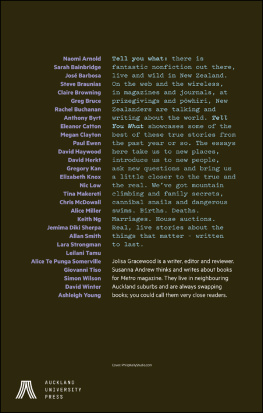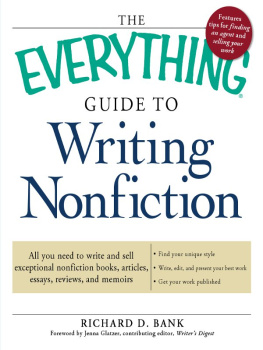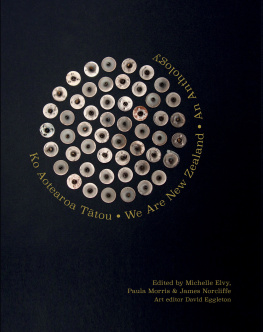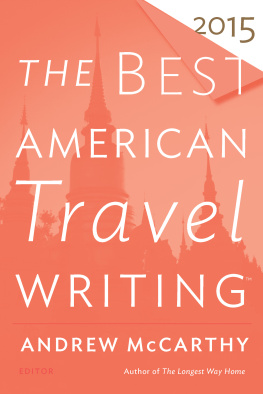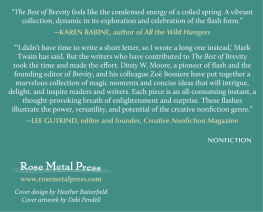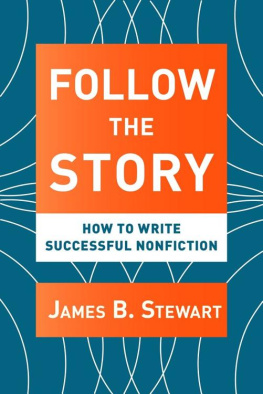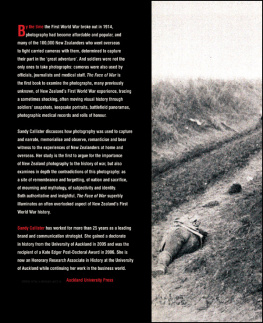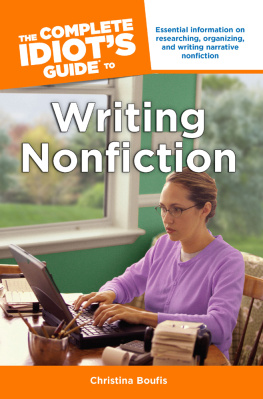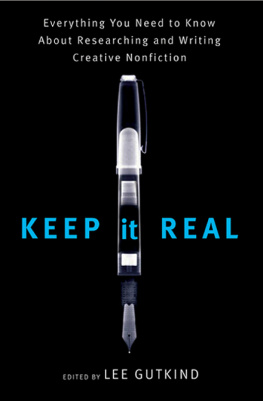Tell You What
Great New Zealand Nonfiction 2015
Edited by Jolisa Gracewood
& Susanna Andrew
Contents
Anthony Byrt
Eleanor Catton
Giovanni Tiso
Lara Strongman
David Haywood
Nic Low
Megan Clayton
Naomi Arnold
Greg Bruce
Steve Braunias
Leilani Tamu
Jos Barbosa
Ashleigh Young
Paul Ewen
Tina Makereti
Rachel Buchanan
Simon Wilson
Keith Ng
David Winter
Claire Browning
Alice Te Punga Somerville
David Herkt
Gregory Kan
Jemima Diki Sherpa
Sarah Bainbridge
Elizabeth Knox
Alice Miller
Chris McDowall
Introduction
Tell you what, someone says, on impulse or on reflection and were hooked. The words promise a revelation, a shift, a new truth. This book celebrates that call and response by gathering some great nonfiction reads from the last few years: a buzz of voices that captures what we were thinking.
Were surrounded by true stories these days. Reportage, memoirs, essays, musings, blog posts, tweets; so much to read, from so many places, so little time. But whether published on paper or online, or delivered aloud to a one-off audience, much of this material remains ephemeral. It holds you in its spell for a moment, then disappears into the recycling pile or browser cache.
So weve summoned a timely selection of these fugitive pieces back into the light, to reveal the strength and variety of nonfiction in New Zealand right now. Together on the page, these writers illuminate a moment in time.
Our inspiration was twofold. First, it had never been done before. Why, we found ourselves wondering, doesnt New Zealand have its own equivalent of the Best American Essays or Best Australian Essays series? Surely we have enough great nonfiction to fill a book on a regular basis?
Secondly, we love a challenge, and one was posed by Metro magazine editor Simon Wilson in July 2013, when in a review of a legendary exponent of long-form journalism, he asked: Where is our Janet Malcolm? His best guess: whoever she was, she was too busy tweeting.
The response at least, as soon as the review was posted on the magazines website was swift. Its easy to lament what we do not have in New Zealand, responded poet and essayist (and regular tweeter) Ashleigh Young on her blog. Our voices necessarily come from a different place. I think were at the beginning of something; were witnessing a slow but sure surge of interest in the kinds of nonfiction that do illuminate things around us and in us.
In fact, Wilson had it backwards, replied blogger and translator Giovanni Tiso on his own blog. Poetry, fiction and creative nonfiction thrive on the New Zealand web, he argued. These kinds of online writing are consistently bolder, hence more relevant, than what one reads in print. In other words, while Janet Malcolm may have a New Yorker budget and readership, we have broadband enough, and time. We also have an open, supportive writing community; and, while our literary marketplace is small, most editors are a friend of a friend of a friend or a retweet away.
Some of our freshest writing is definitely to be found online fully half the contents of this collection were originally published on the web. But wherever you find it in the unruly richness of the blogosphere, on the radio, at a live event, on a magazine rack or wrapped around your fish and chips non-fiction is a vital part of our cultural landscape.
Steve Braunias, himself approaching the status of nonfiction national treasure, said in a speech in September 2013 that our most accomplished literature is our history and biography. And yet, perhaps by virtue of its name, which tells you what it isnt, nonfiction sometimes seems to occupy a second-class status or worries that it does. Braunias pointed to novelist Emily Perkins blurb on the cover of his award-winning collection Civilisation, which praised it as being like a series of great New Zealand novels bound up in one extraordinary book. His riposte: Will someone say on the cover of Emilys next book, Its like a series of great books of New Zealand nonfiction bound up in one extraordinary novel?
Of course, these are two sides of the same coin: extraordinary novels spring from life observed we often say they ring true while extraordinary nonfiction, as Perkins suggests, can be every bit as artful as its made-up counterpart. Undeniably, too, great books of New Zealand nonfiction hold their own as the complement to our great novels, dominating sales and doing well at awards. But whereas the short story is, as Lydia Wevers has argued, something of a national specialty, regularly anthologised and valorised by competitions, our short nonfiction still struggles to find the light. Which is why we set out to celebrate the genuine article, sufficient in itself.
Our temporal starting point for this collection was the Canterbury earthquake of September 2010, an event that shook loose our beliefs about what could happen when and where; buildings broke and words came tumbling out. Among other dates we might have chosen, this one felt somehow definitive. And then we began hunting.
Our scope was nonfiction in the broadest sense, perhaps because the word essay sounds to New Zealand ears like homework; and by great we meant astute, astonishing, absorbing, provocative, riveting and true. We threw a wide net, both here and overseas, for writing that told us something we didnt know, or upended something we thought we knew. We asked around for stories that had stuck with readers, that invited re-reading, that begged to be passed on.
With Emily Dickinsons line in mind Tell all the truth but tell it slant we looked for sincerity with style. We prized distinctive voices, whether artful or blunt, exploratory or argumentative. We sought writing with a real feeling for prose; with seriousness, flourish, humour, swagger; with a sense of authority or of gathering doubt. Writing that catches the reader by surprise is memorable; a writer taking herself by surprise is even more disarming.
We found writers pondering the cost of living, both metaphorical and literal: the trade-offs of modern life and dangerous work. We found writers on the move, tracing the travels of people, of notions, of practices and objects. We found writers pursuing the idea of home, an old theme with increasingly worldly twists. And we found New Zealand all over the map: observed and observing from small towns, from distant metropolises and from the highest mountain in the world.
Larger-than-life figures stride through these pages, young and old: some well-known, others perfectly ordinary and yet extraordinary in their own way. There are public tragedies and private disasters; quests and questions; the odd mystery. And on every page theres an attention to the strange, slippery magic of stories the way we pass them on or hold them close; how much of our history is hidden from view; how much of it is hiding in plain sight.
The book begins with a recollection of being shoved unexpectedly into the realm of nonfiction and ends with instructions for heading back out into the world. Along the way, youll encounter an ICU, a credit card, a rotary clothesline, a crack in the floorboards, a builders level, a set of bells, a hollow needle, the good knives, an open home, an egg, a window, a pair of undies, a bike helmet, a whare, a buried forest, an Elvis LP, a fish trap, a snail, a garden, a tattoo, a pair of budgies, a glittering mosaic, a uniform, an avalanche, a stethoscope, a loose weatherboard, a cold beer and an orange.

